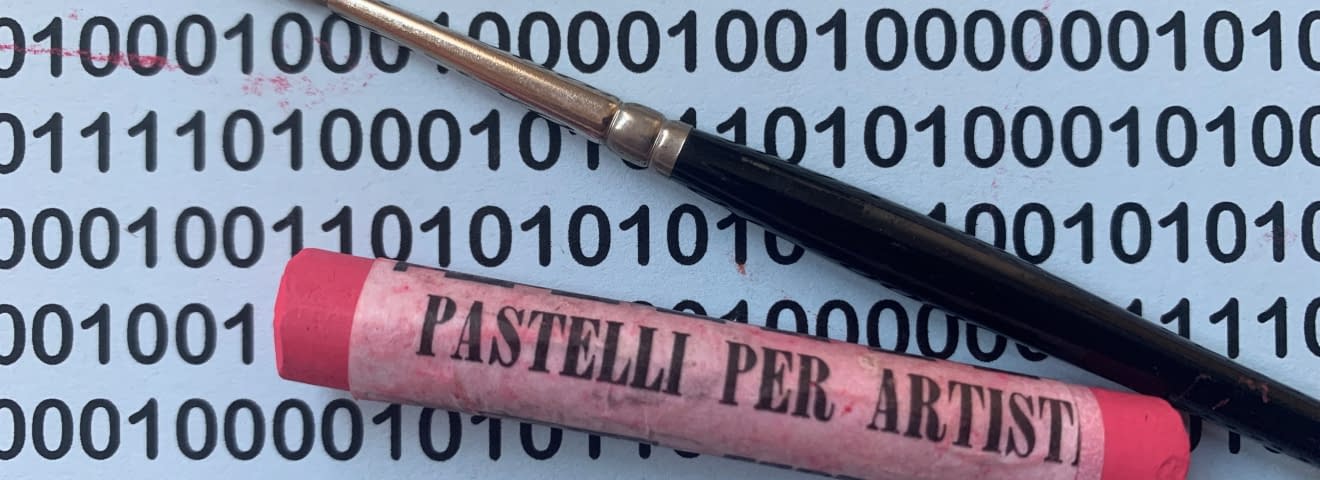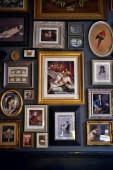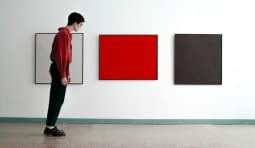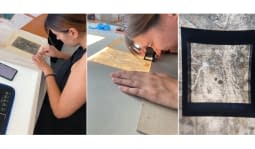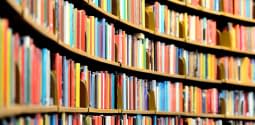Artificial intelligence and art – an approach
A machine is drawing
With a rattle and a squeak, the motorised drawing machine starts up at the push of a button. The pen I have fixed in the movable holder scribbles across a sheet of paper in a controlled manner. In a short time, an abstract drawing is created out of scrawly strokes and lines. The machine continues to draw independently. That is until I stop the process. Or until time runs out. It was invented and constructed by Jean Tinguely (1925–1991), a main representative of the kinetic art movement in the late 1950s. According to the principle: set the machine in motion and you become an artist. Irritated, I look at the drawing. It was created by the principle of chance. As documented on the back of the sheet, it is is in fact an original Tinguely work. Even though it was created with an emotionless machine and can be copied x times by anyone at any time. Tinguely's intelligent humour and his interest in the relationship between humans and machines makes me feel like an artist for a few minutes. But will machines ever (be able to) replace artists? Am I really in possession of a real Tinguely? My first encounter with a «Méta-Matic» in the Museum Tinguely in Basel over 15 years ago raised a number of questions.
Artificial and/or human creativeness?
Since then, modern technologies have emerged and, linked to them, numerous new fields of application that are constantly being developed further – including in the field of art: In the context of algorithms and artificial intelligence (AI), big tech, augmented reality (AR), robotics, bionics, etc., we might smile at these simple robot machines of a Tinguely or Nam June Paik (1932–2006). But their questioning of the role of artists, their works and their audience in an increasingly commercialised art market through the integration of machines has triggered many processes of redefinition and expansion of the concept of art in the following decades. For example, the art and research platform Art Laboratory Berlin (ALB), founded in 2006, is dedicated to the mediation and presentation of contemporary interdisciplinary art projects and connects art, science and technology, while ETH Zurich focuses on AI, architecture and design. It remains exciting in times of digital modernity: Is artificial creativity on an equal level with human creativity? When is art art and who can call themselves an artist, when any person with (almost) equal rights can experiment on the net using special graphics software or programmes (such as DeepDream by Google; DALL-E by OpenAI; Cloudpainter by AI artist Pindar Van Arman; Runway ML, etc.)? How are copyrights, originality and authenticity to be valuated when digital computing systems create works from millions of data? Will automatised art one day overtake or even replace analogue art, which was learned through creativity, imagination, intuition and inspiration?
AI = AI?
Artificial intelligence has long been part of the art world, subverting the notion that art is necessarily linked to human creativity. Computer technologies are used as tools, aids, sources of inspiration, in artist duos (as proven by AI pioneer Harold Cohen (1928–2016) and his 1974 algorithm AARON) or «as artists» for the production of artworks: For example, in «The Next Rembrandt» (project of Delft University of Technology, Microsoft, ING Bank, Museum Het Rembrandthuis, Mauritshuis), which stunned the art world with a seemingly real Rembrandt in 2016; the autonomous-creative and patented algorithm AICAN (Artificial Intelligence Creative Adversarial Network by Prof. Ahmed Elgammal), which was presented at Art Basel in 2017; the portrait «Edmond de Belamy», programmed in 2018 by the French artist collective Obvious with the help of computer specialists and signed using an algorithm element, which was auctioned for 432,500 dollars by the Christies auction house; or the AI recently developed by Tomo Savić-Gecan for the Croatian Pavilion at the Venice Biennale 2022, at which Ai-Da can also be discovered as a painting robot lady.
Social machines with intuition and empathy?
It's spectacular. But researchers only see it as an intermediate step on the AI path. Like Deep Learning, which tracks the learning of the human brain and is intended to help artificial intelligent systems achieve more autonomy in their creative activity. For Daniel Bisig, a biologist, artist and member of the ICST at the Zurich University of the Arts, this form of artificial intelligence is «[...] very self-centred, hardly interactive and therefore possibly asocial. ... The future belongs to clever machines that are at the same time social.» (Daniel Bisig). Kenric McDowell, engineer and musician, is also working on projects in which humans cooperate with the machine and interactions between humans and software take place. McDowell is convinced that «[...] the arts ... (must) play a key role in this, focusing on our subjectivity and on essential human experiences such as empathy and mortality». (Kenric McDowell in conversation with Hans Ulrich Obrist at the Google Cultural Institute, 2020). In creative, artistic processes, flesh-and-blood artists make decisions (often intuitively) out of empathy, emotional sensitivities, individual and general experiences, but also in the knowledge of their own mortality. Will future artificial systems ever be able to learn this? Will there one day be creatively active machines that «[...] could perceive themselves as creative and also describe themselves as such. [...] (who) [...] would compete with each other because they had enviously observed how creative some of them are [...]», as Hanno Rauterberg speculates in his essay The Art of the Future? This is contradicted by Sami Haddadin, one of the world's leading innovative researchers in AI and robotics. On the occasion of the current exhibition in Munich's Pinakothek der Moderne, he says: «Intelligent robots are human assistants and will remain so for a very long time. Everything else is science fiction, though an inspiring and fascinating one.» (Sami Haddadim). We'll see... and just keep on calculating...
I would like to thank Claudia Marschall (experimenta gGmbH, Heilbronn) for valuable information and professional support.
